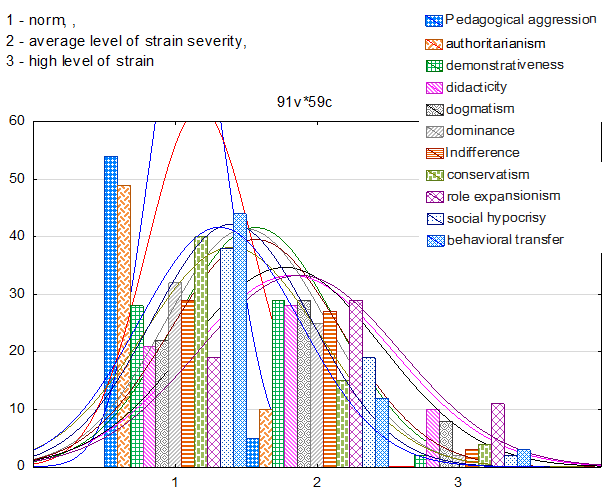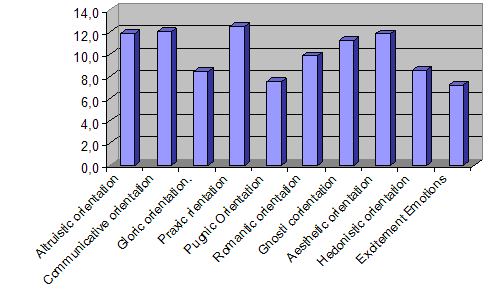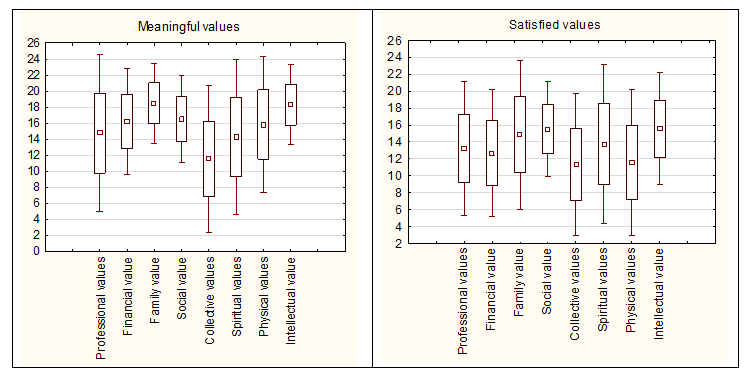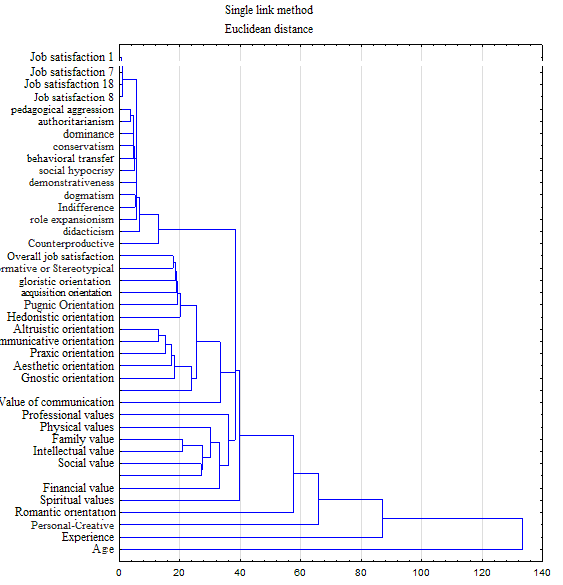Abstract
Pedagogical work is associated with the manifestations of significant emotional, intellectual, informational load, physical and psycho-physiological stresses and their consequences. A high level of involvement of an individual in their work, and deep reflexive analysis of their professional experience can neutralize the deforming effect of these loads. That is why researchers are increasingly turning to the problem of motivation for teachers to work and to the mechanisms for the occurrence of professional deformation. The model of mechanisms of occurrence professional deformations of the teacher is proposed for discussion. The central elements of the model were the components of the subject's motivation-need sphere and personal characteristics and qualities associated with it. These qualities determine both professional and personal development of the subject, or occurrence of professional deformations. The subjects of empirical analysis were the emotional orientation of teachers, value orientations, motivation, degree of job satisfaction, level of competence in social interaction, and coping behavior in problem situations. Their correlation with professional deformation in teachers has been studied. It is revealed that more often the indicators of professional deformations correlate with characteristics of work which correspond to needs of the subject: for example in the status or the power. It is concluded that the personal and professional qualities of the teacher play a leading role in the emergence of professional deformation, and working conditions create an environment that contributes to their development. The program of psychological support of personal and professional development of teachers is offered.
Keywords: Pedagogical activityprofessional deformationprofessional burnout
Introduction
The question of a teacher’s professional competence, his personal readiness and psychological conformity to the social and educational tasks facing him, are the subject of extensive discussion in the scientific community. By educating the younger generation, teachers actually shape the image of future society. The responsibility of this performed social task requires high demand for its performers.
Problem Statement
A unique aspect of being a teacher is that, on one hand, professional requirements for teachers as specialists are constantly growing. This involves continuous work on their self and their skills. The nature of the audience with which the teacher has to work is changing. The amount of information the teacher has to master and operate is overwhelming. The information and pedagogical technology used in the educational environment are changing. The learning process is intensifying. On the other hand, pedagogical work is associated with experiencing significant emotional, intellectual, informational, physical and psycho-physiological stresses and their consequences. Only a high level of personal involvement in this work, professional activity, and a deep reflexive analysis of one's own experience in acmeological maturation can ensure effective activity and level out the deforming effect. That is why researchers are increasingly turning to the problem of the formation of motivation of teachers' work and the prevention of the occurrence of professional deformation.
Research Questions
The issue of motives and motivation was widely discussed in the works of such scientists as Lewin (2001), Godefroid (1988), Heckhausen (2003), Rubinstein (2000), Lomov (1984), Vilyunas (1990), Kovalev (1988) and other scientists. Motives allow you to clearly trace the systemic manifestations of the psyche and the orientation of the subject (Platonov & Schwartz, 1948; Rubinstein, 2000). According to Rubinshtein (2000), the motive, as the determining force, permeates all the basic components of the personality structure and is manifested in the direction, character, emotions, resources, and mental processes accompanying a person’s activity.
In the works of Leontiev (1971), Ilyin (2006), Kovalev (1988), when choosing a profession, a person performs a kind of projection of his motivational structure on a system of factors that are associated with the performance of the professional activity and through which a person seeks to satisfy their needs.
For their part, objective working conditions create an environment in which the individual-personal characteristics and qualities of the person of labor unfold and manifest themselves (Klimov, 2004). First of all, this has to do with the sphere of motivational need and all personal structures associated with it (Anderson & Iwanicki, 1984; Druzhilov, 2010).
In the works of Aminov (1997), Zimnyaya (1999), Novikov and Batyshev (2009), Shadrikov (2013), it is shown that the profession of the teacher as a socionomic profession that makes significant demands on social and communicative skills and abilities of the teacher as well as on the content and direction of its motivational sphere.
As shown in works of Aminov (1975), Markova (1996), Zeer (2005), Rogov (2016), Bakker, Demerouti, and Euwema (2005), if these qualities correspond to the content, goals, and objectives of the professional activity, then it becomes a condition that develops the personality both professionally and personally. In the case where the motives and goals of the teacher differ from the goals and objectives of the professional activity, psychological exhaustion happens and the teacher either leaves the space of the given activity, or develops professional deformation (Maslach & Jackson, 1981; Formanyuk, 1994; Montgomery & Rupp, 2005; Gordienko, 2008; Fernet, Guay, Senectal, & Austin, 2012; Hakan & Dincerol, 2013).
Professional deformation is defined by Zeer (2005) as changes in the personality structure associated with work, violating the integrity of the personality, reducing its adaptability and stability, the development of stereotypical approaches to professional behavior, and the emergence of psychological barriers to the development of new technologies, professions, and specialties.
In order to ensure the prevention of professional deformations, it is necessary to understand the mechanism of their occurrence.
It was hypothesized that the emergence of professional deformations is associated with personal qualities of teachers, which act as mechanisms mediating the influence of professional activity. Based on the theoretical analysis of previous studies, a model of mechanisms for the occurrence of professional deformities among teachers was built. The main components affecting the personality in this model are two groups of factors:
factors caused by the objective specificity of the activities of teachers, and
factors of a socio-psychological nature, which are not direct components of a pedagogical activity, but directly related to it (features of the teaching staff, attitudes towards this profession in society, features of the contingent with which the teacher has to interact, etc.).
The third group of factors is personal characteristics and qualities, acting as mechanisms mediating the action of two other groups of factors. They either reinforce the negative impact of objective professional and socio-psychological factors of labor, and then the subject develops professional deformations, or offset their negative influence, providing the subject with additional resources for professional and personal development.
Understanding the nature of professional personality deformities allows you to create programs for their prevention, as well as to determine the psychological complexes of properties and qualities with which you need to work at the stage of training.
Purpose of the Study
The personal factors of professional deformations of teachers were studied.
The emotional orientation of teachers, values orientations, motivation and degree of job satisfaction, competence in social interaction, and fixed strategies of behavior in problem situations were empirically analyzed. The level of professional burnout and the severity of professional deformations in the group of teachers who formed the core of the pedagogical group of the school (62 people in total) were studied. Methodical tools included a set of test procedures, fixed interviews, and self-reports, as well as mathematical analysis of the results obtained using the SPSS statistical software package.
The aim of the study was to research is the correlation of the leading motives of the professional activity of teachers with various forms of professional deformation and substantiate the directions of psychological support for teachers' activities in order to prevent the occurrence of professional deformities.
Research Methods
The methodological base of the research used the theories of motivation of Lewin (2001), Heckhausen (2003), Rubinshtein (2000), Leontiev (1971); concepts of motivation of professional activity of Lomov (1984), Vilyunas (1990), Kovalev (1988), Kuzmina (1993), Ilyin (2006), Platonov & Schwartz (1948). The methodical tools included a set of test procedures, arranged interviews and self-reports, as well as mathematical analysis of the results obtained using the statistical software package STATISTICA-10.
The following methodological tools were implemented:
method of assessing job satisfaction (Kulagin, 2009);
rapid diagnostics of the social values of the individual (Fetiskin, Kozlov, & Manuilov, 2002);
“Determination of the General Emotional Orientation of the Individual” and methodology for measuring the competence of social interaction (Kodintseva, 2006);
Questionnaire “Professional (Emotional) Burnout” (MBI) by Maslach and Jackson (1981) in the adaptation of Vodopyanova (2000);
assessment of professional and pedagogical deformations of Zeer (2005).
The study was conducted on the basis of the municipal state-funded educational institution “Secondary School” of the municipal district of the city district in Simferopol of the Republic of Crimea. The study involved 62 teachers representing the school team. The group included participants with different experience and work experience, different gender, and age groups.
Findings
The method of assessment of professional and pedagogical deformation of Zeer (2005) was used for the analysis of the degree of severity of professional deformation in the group of teachers that participated in the study. It was established that nearly all types of professional deformations are present in this group at different levels of severity (Figure
The average level of severity of these strains shows almost half of the studied sample. A third of the sample is characterized by “social hypocrisy” (loss of sincerity, the transformation of social desirability into the habit of moralizing) and “conservatism” (prejudice against everything new, the transformation of stereotypical methods into clichés, saving intellectual forces). A fifth of the sample demonstrates a high level of didacticism, conservatism and role expansionism.

Attention is drawn to the fact that only three of the eleven deformations described show a positive correlation with experience and even then it is rather low: dogmatism (r = 0.38), indifference (r = 0.34), behavioral transfer (r = 0.33 ), at p <0.05. The fact that, among the teachers who showed the presence of professional deformations, there were quite a few who had relatively little experience (from 3 to 5 years) indicates that the occurrence of professional deformation is due to certain personal characteristics of the subject.
To study the motivation and professional orientation of teachers, the method “Assessment of Satisfaction with Work” by Kulagin (2009) was used. In this method, a list of 23 characteristics of labor is presented to the subject and it is proposed to evaluate their significance and level of satisfaction. It is assumed that the significance of certain characteristics of labor for the teacher is determined by the motives that are leading in choosing this profession.
Ranking showed the priority for most teachers concerned such labor parameters as stability and predictability of the situation, comfortable conditions in which the activity takes place, regulated relations in the team, generally accepted values, rules and norms, a comfortable psychological climate, stability and reliability of the workplace, material and social incentives for work (Table
To summarize the motives behind this choice, they can be briefly referred to as stability, certainty, predictability and comfort.
This part of job motives can be referred to as creativity, growth and development. As can be seen from Table
Analysis of the degree of satisfaction with the various parameters of labor (Table
Low rates were noted for such factors of labor as benefits and social package (0.25), corporate events, holidays (0.26), career growth opportunities (0.25). This distribution of data indicates dissatisfaction of teachers with a social package that compensates for their work, the volume of activities that ensure the corporate climate (the presence of holidays, traditions, joint events), as well as career growth opportunities.
The definition and identification of various types of emotional orientation made it possible to identify a group of teachers who have pronounced indicators of the “Praxical Emotional Orientation” type (an average group of 12.5). A high result in this type of orientation indicates that the subject is predominantly active in achieving the goals set and achieving the desired results. Also, good results were obtained by the “Communicative Orientation” type (group average 12.05), which indicates a pronounced need for communication (Figure

The results indicate that about half of the subjects (47.5%), who in situations of social interaction demonstrate good knowledge and use of social norms and stereotypes, actively apply a creative approach in social interaction, i.e. own their own social “heuristics” and “coping strategies”.
Another 44.1% of the subjects have a standard or stereotypical level of CSI, that is, in social behavior they prefer to act according to prepared templates, “scripts,” “scenarios,” rely on generally accepted norms and stereotypes in solving social situations. A small part of the sample group (8.5%) shows a low level of competence in social interaction. This level is rated as counterproductive and is characterized by low activity, a desire to limit social contacts, poor understanding of social norms and stereotypes, and a desire to shift the initiative to partners in social interaction when problems arise.
In other words, subjects with counterproductive and regulatory levels of CSI development do not have sufficient resources to creatively solve problematic situations in social interaction, or for certain reasons are not ready to apply a creative approach in social behavior.
To identify personal, professional, and socio-psychological orientations and preferences, a quick diagnosis of the social values of the individual was used (Fetiskin, Kozlov, & Manuilov, 2002). Indicators were obtained concerning a group of significant values and satisfaction of social values in the studied group of teachers (Figure

High results in the “significant values” group show “family values” (average for the group is 18.5) and “intellectual” (average for the group is 18.3). The low indicator in the “significant values” group was marked on the scale of “social values” (the average indicator for the group is 11.6).
In the “satisfied social values” group, high indicators were obtained on the scales of “social” (group average 15.5) and “intellectual” values (group average 15.6). The “social values” group scored low (the average indicator of the group was 11.4).
The use of cluster analysis made it possible to establish which of the studied psychological variables are associated with professional deformations of teachers (Figure
The integral indicator of professional burnout forms a complex of relations with such types of emotional orientation as “gloric” (expressed need for fame), “acquisitive” (propensity for acquisitiveness), “frightened” (need for security), and “hedonistic” (need for physical and spiritual comfort). The same complex includes the indicator “normative level of social competence,” expressed in the striving of the subject in solving social situations to rely on generally accepted norms and stereotypes, to act according to predefined templates and scenarios.

The scale of professional efficiency forms a complex of connections with the personal-creative level of competence of social interaction and orientation to spiritual and family values.
It is noteworthy that neither experience nor age plays a significant role in the formation of professional deformation. Obviously, age and experience are important only for the unfolding of potentially embedded personal bases for the formation of professional deformations.
Conclusion
Summarizing the analysis of the interrelations of professional deformations with various components of teachers’ motivation-need sphere, we can say that the hypothesis presented at the beginning of the study is confirmed: the influence of profession factors and the conditions in which it occurs is mediated by the personality of the subject. The main mechanism of this mediation is the subject's motivation-needs sphere. Values, needs, and motives determine goals.
These goals, being realized in the space of professional activity, either become a source of additional development (for example, motives of creativity or self-development) or create conditions for professional deformation (for example, motives of power or avoidance of responsibility). The mode and potential of influence of a certain motive on the formation of professional deformation are determined by the degree of its compliance with the objective goals and objectives of the profession. In the case when the motive is not satisfied in the realm of the chosen profession, we can assume that the subject is likely to leave it.
Another conclusion that can be made on the basis of the correlation obtained is that the mechanisms of social reflection act as a tool for the formation of adequate goals (goal setting), for an objective analysis of the results of work (analysis and evaluation), for the formation of adequate ways to manage the process of progression towards the goal and overcoming obstacles on the way to it (dedication and purposefulness).
Accordingly, the program for the prevention of professional deformation in pedagogical workers should be aimed at enhancing the skills of self-reflection, self-regulation, control of the psycho-emotional state and skills of positive self-perception through social and cultural work.
Based on the materials received, a psychological support program was developed and recommended for the development of the teacher’s personality: increasing the level of competence of social interaction, expanding models of adaptive behavior, and also reflexive development of the components of the motivational and needful sphere of professionally oriented acmeological practice.
References
- Aminov, N. A. (1997). Model characteristics of abilities and giftedness of the teacher. Ability (to the 100th anniversary of the birth of B. M. Teplov). Dubna: Phoenix.
- Aminov, N. A. (1975). Some theoretical aspects of the differential psychodiagnostics of special abilities. Moscow: Smysl.
- Anderson, M. B., & Iwanicki, E. F. (1984). Teacher motivation and its relationship to burnout. Educational Administration Quarterly, 20, 94-132.
- Bakker, A. B., Demerouti, E., & Euwema, M. (2005). Job resources buffer the impact of job demands on burnout. Journal of Occupational Health Psychology, 10, 170-180.
- Druzhilov, S. A. (2010). Individual human resource as the basis for the development of professionalism. Voronezh: Scientific book.
- Fernet, C., Guay, F., Senectal, C., & Austin, S. (2012). Predicting intraindividual changes in teacher burnout: The role of perceived school environment and motivational factors. Teaching and Teacher Education, 28, 514-525.
- Fetiskin, N. P., Kozlov, V. V., & Manuilov, G. M. (2002). Socio-psychological diagnosis of personal development and small groups. Moscow: Publishing House of the Institute of Psychotherapy.
- Formanyuk, T. V. (1994). Emotional Combustion Syndrome as an Indicator of Teacher's Professional Disadaptation. Voprosy Psychology, 6, 54-67.
- Godefroid, J. (1988). Les chemins de la psychologie. Paris: Mardaga.
- Gordienko, N. V. (2008). Psychological support for the prevention of professional deformation of the personality of the teacher (Unpublished doctoral dissertation). Stavropol: Stavropol State University.
- Hakan, K. O. Ç., & Dincerol, C. (2013). A Study Professional and Job Burnout on Teachers. International Journal of Humanities and Social Science, 3(13), 26-38.
- Heckhausen, H. (2003). Motivation and activity. St. Petersburg: Piter.
- Ilyin, E. P. (2006). Motivation and motives. St. Petersburg: Piter.
- Klimov, E. A. (2004). Pedagogical work: psychological components: Textbook. Moscow: MGU Publishing House.
- Kodintseva, N. M. (2006). Experience creating measurement methods, competence of social interaction Introduction. Background. Psychological diagnostics, 3, 27-46.
- Kovalev, V. I. (1988). Motives of behavior and activity. Moscow: Nauka.
- Kulagin, O. A. (2009). Methods of evaluation of staff satisfaction. Handbook of personnel management, 8, 56-60.
- Kuzmina, N. V. (1993). Professionalism of pedagogical activity. St. Petersburg: Piter.
- Leontiev, A. N. (1971). Needs, motives, emotions. Moscow: Nauka.
- Lewin, K. (2001). Dynamic psychology. Moscow: Smysl.
- Lomov, B. F. (1984). Methodological and theoretical problems of psychology. Moscow: Nauka.
- Markova, A. K. (1996). Psychology of professionalism. Moscow: Znaniya.
- Maslach, C., & Jackson, S. (1981). The Measurement of Experienced Burnout. Journal of Occupational Behavior, 2, 99-113.
- Montgomery, C., & Rupp, A. (2005). A meta-analysis for exploring the diverse causes and effects of stress in teachers. Canadian Journal of Education, 28, 461-488.
- Novikov, M. A., & Batyshev, S. Y. (2009). Professional pedagogy: Textbook for students of pedagogical specialties and directions. Moscow: AGUES.
- Platonov, K., & Schwartz, L. (1948). Studies in the psychology of pilots. Moscow: Military publishing aim of the Soviet Union.
- Rogov, E. I. (2016). Psychology of formation of professionalism (in socionomic professions). Rostov-on-don: Southern Federal University press.
- Rubinstein, S. L. (2000). Fundamentals of General Psychology. St. Petersburg: Piter.
- Shadrikov, V. D. (2013). Psychology of human activity. Moscow: Institute of psychology RAS press.
- Vilyunas, V. K. (1990). Psychological mechanisms of human motivation. Moscow: MGU.
- Vodopyanova, N. E. (2000). The syndrome of "mental burnout" in communicative occupations. Health Psychology, 443-462.
- Zeer, E. F. (2005). Modernization of vocational education: competence approach: studies. Manual. Moscow: MPSI.
- Zimnyaya, I. A. (1999). Pedagogical psychology. Moscow: Logos.
Copyright information

This work is licensed under a Creative Commons Attribution-NonCommercial-NoDerivatives 4.0 International License.
About this article
Publication Date
23 January 2020
Article Doi
eBook ISBN
978-1-80296-077-8
Publisher
European Publisher
Volume
78
Print ISBN (optional)
-
Edition Number
1st Edition
Pages
1-838
Subjects
Teacher, teacher training, teaching skills, teaching techniques
Cite this article as:
Khairova*, S. I. (2020). Reflexive Training As Protection Against Professional Deformation In Teaching Profession. In R. Valeeva (Ed.), Teacher Education- IFTE 2019, vol 78. European Proceedings of Social and Behavioural Sciences (pp. 360-370). European Publisher. https://doi.org/10.15405/epsbs.2020.01.42
